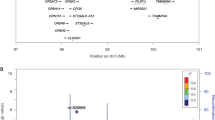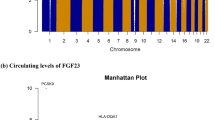Abstract
Interleukin-1-receptor antagonist (IL-1RA) modulates the biological activity of the proinflammatory cytokine interleukin-1 (IL-1) and could play an important role in the pathophysiology of inflammatory and metabolic traits. We genotyped seven single nucleotide polymorphisms (SNPs) that capture a large proportion of common genetic variation in the IL-1RN gene in 1256 participants from the Invecchiare in Chianti study. We identified five SNPs associated with circulating IL-1RA levels with varying degrees of significance (P-value range=0.016–4.9 × 10−5). We showed that this association is likely to be driven by one haplotype, most strongly tagged by rs4251961. This variant is only in weak linkage disequilibrium (r2=0.25) with a previously reported variable number of tandem repeats polymorphism (VNTR) in intron-2 although a second variant, rs579543, that tags the VNTR (r2=0.91), may also be independently associated with IL-1RA levels (P=0.03). We found suggestive evidence that the C allele at rs4251961 that lowers IL-1RA levels is associated with an increased IL-1β (P=0.03) level and may also be associated with interferon -γ (P=0.03), α-2 macroglobulin (P=0.008) and adiponectin (P=0.007) serum levels. In conclusion, common variation across the IL-1RN gene is strongly associated with IL-1RA levels.
This is a preview of subscription content, access via your institution
Access options
Subscribe to this journal
Receive 6 digital issues and online access to articles
$119.00 per year
only $19.83 per issue
Buy this article
- Purchase on Springer Link
- Instant access to full article PDF
Prices may be subject to local taxes which are calculated during checkout



Similar content being viewed by others
References
Witkin SS, Gerber S, Ledger WJ . Influence of interleukin-1-receptor antagonist gene polymorphism on disease. Clin Infect Dis 2002; 34: 204–209.
Gabay C, Smith MF, Eidlen D, Arend WP . Interleukin 1 receptor antagonist (IL-1Ra) is an acute phase protein. J Clin Invest 1997; 99: 2930–2940.
Ferrucci L, Corsi A, Lauretani F, Bandinelli S, Bartali B, Taub DD et al. The origins of age-related proinflammatory state. Blood 2005; 105: 2294–2299.
McDermott MM, Guralnik JM, Corsi A, Albay M, Macchi C, Bandinelli S et al. Patterns of inflammation associated with peripheral arterial disease: the InCHIANTI study. Am Heart J 2005; 150: 276–281.
Biasucci LM, Liuzzo G, Fantuzzi G, Caligiuri G, Rebuzzi AG, Ginnetti F et al. Increasing levels of interleukin (IL)-1Ra and IL-6 during the first 2 days of hospitalization in unstable angina are associated with increased risk of in-hospital coronary events. Circulation 1999; 99: 2079–2084.
Cesari M, Penninx BW, Pahor M, Lauretani F, Corsi AM, Rhys Williams G et al. Inflammatory markers and physical performance in older persons: the InCHIANTI study. J Gerontol A Biol Sci Med Sci 2004; 59: 242–248.
Fisher Jr CJ, Dhainaut JF, Opal SM, Pribble JP, Balk RA, Slotman GJ et al. Recombinant human interleukin 1 receptor antagonist in the treatment of patients with sepsis syndrome. Results from a randomized, double-blind, placebo-controlled trial. Phase III rhIL-1ra Sepsis Syndrome Study Group. JAMA 1994; 271: 1836–1843.
Fiocco U, Vezzu M, Cozzi L, Todesco S . IL-1Ra (recombinant human IL-1 receptor antagonist) in the treatment of rheumatoid arthritis: the efficacy. Reumatismo 2004; 56: 62–73.
Nicklin MJ, Hughes DE, Barton JL, Ure JM, Duff GW . Arterial inflammation in mice lacking the interleukin 1 receptor antagonist gene. J Exp Med 2000; 191: 303–312.
Ferrari D, Pizzirani C, Adinolfi E, Lemoli RM, Curti A, Idzko M et al. The P2X7 receptor: a key player in IL-1 processing and release. J Immunol 2006; 176: 3877–3883.
Elaraj DM, Weinreich DM, Varghese S, Puhlmann M, Hewitt SM, Carroll NM et al. The role of interleukin 1 in growth and metastasis of human cancer xenografts. Clin Cancer Res 2006; 12: 1088–1096.
Stylianou E, O'Neill LAJ, Rawlinson AJ, Edbrooke MR, Woo P, Saklatvala J . Interleukin 1 Induces NF-κB through its type I but not its type II receptor in lymphocytes. J Biol Chem 1992; 267: 15836–15841.
Cai D, Yuan M, Frantz DF, Melendez PA, Hansen L, Lee J et al. Local and systemic insulin resistance resulting from hepatic activation of IKK-beta and NF-kappaB. Nat Med 2005; 11: 183–190.
Danis VA, Millington M, Hyland VJ, Grennan D . Cytokine production by normal human monocytes: inter-subject variation and relationship to an IL-1 receptor antagonist (IL-1Ra) gene polymorphism. Clin Exp Immunol 1995; 99: 303–310.
Strandberg L, Lorentzon M, Hellqvist A, Nilsson S, Wallenius V, Ohlsson C et al. Interleukin-1 system gene polymorphisms are associated with fat mass in young men. J Clin Endocrinol Metab 2006; 91: 2749–2754.
Hurme M, Santill S . IL-1 receptor antagonist (IL-1Ra) plasma Levels are coordinately regulated by both IL-1Ra and IL-1beta genes. Eur J Immunol 1998; 28: 2598–2602.
Marculescu R, Endler G, Schillinger M, Iordanova N, Markus E, Hayden E et al. Interleukin-1 receptor antagonist genotype is associated with coronary atherosclerosis in patients with type 2 diabetes. Diabetes 2002; 51: 3582–3585.
Vijgen L, Van Gysel M, Rector A, Thoelen I, Esters N, Ceelen T et al. Interleukin-1 receptor antagonist VNTR-polymorphism in inflammatory bowel disease. Genes Immun 2002; 3: 400–406.
Johnson GC, Esposito L, Barratt BJ, Smith AN, Heward J, Di Genova G et al. Haplotype tagging for the identification of common disease genes. Nat Genet 2001; 29: 233–237.
Abbatecola AM, Ferruci L, Grella R, Bandinelli S, Bonafe M, Barbieri M et al. Diverse effect of inflammatory markers on insulin resistance and insulin resistance syndrome in the elderly. J Am Geriart Soc 2004; 52: 399–404.
Arend WP, Gabay C . Physiologic role of interleukin-1 receptor antagonist. Arthritis Res 2000; 2: 245–248.
Bruun JM, Lihn AS, Verdich C, Pedersen SB, Toubro S, Astrup A et al. Regulation of adiponectin by adipose tissue-derived cytokines: in vivo and in vitro investigations in humans. Am J Physiol Endocrinol Metab 2003; 285: 527–533.
Lacquemant C, Froguel P, lobbens S, Izzo P, Dina C, Ruiz J . The adiponectin gene SNP+45 is associated with coronary artery disease in type 2 diabetes mellitus. Diabet Med 2004; 21: 776–781.
Pollin TI, Tanner K, O'Connell JR, Ott SH, Damcott CM, Shuldiner AR et al. Linkage of plasma adiponectin levels to 3q27 explained by association with variation in the APM1 gene. Diabetes 2005; 54: 268–274.
Vasseur F, Helbecqnue N, Dina C, Lobbens S, Delannoy V, Gaget S . Single nucleotide polymorphism haplotypes in both the proximal promoter and exon 3 of the APM1 gene modulate adipocyte secreted adiponectin-hormone levels and contribute to the genetic risk of type 2 diabetes in french caucasians. Hum Mol Genet 2002; 11: 2607–2614.
Somm E, Henrichot E, Pernin A, Juge-Aubry CE, Muzzin P, Dayer JM et al. Decreased fat mass in interleukin-1 receptor antagonist-deficient mice: impact on adipogenesis, food intake, and energy expenditure. Diabetes 2005; 54: 3503–3509.
Ferrucci L, Bandinelli S, Benvenuti E, Di Iorio A, Macchi C, Harris TB et al. Subsystems contributing to the decline in ability to walk: bridging the gap between epidemiology and geriatric practice in the InCHIANTI study. J Am Geriatr Soc 2000; 48: 1618–1625.
Ferrucci L, Guralnik JM, Woodman RC, Bandinelli S, Lauretani F, Corsi AM et al. Proinflammatory state and circulating erythropoietin in persons with and without anemia. Am J Med 2005; 118: 1288.
Carter MJ, di Giovine FS, Jones S, Mee J, Camp NJ, Lobo AJ et al. Association of the interleukin 1 receptor antagonist gene with ulcerative colitis in Northern European Caucasians. Gut 2001; 48: 461–467.
Dudbridge F . Pedigree disequilibrium tests for multilocus haplotypes. Genet Epidemiol 2003; 25: 115–221.
Acknowledgements
This work was supported in part by the National Institutes of Health/National Institute on Aging grant R01 AG24233-01 and by the Intramural Research Program, National Institute on Aging, NIH. DM is supported by a National Health Service (NHS) Executive National Public Health Career Scientist Awards, Ref: PHCSA/00/002.
The InCHIANTI study was supported as a ‘targeted project’ (ICS 110.1RS97.71) by the Italian Ministry of Health, by the US National Institute on Aging (contracts N01-AG-916413, N01-AG-821336 and contracts 263 MD 9164 13 and 263 MD 821336). Michael N Weedon is a Vandervell Foundation Research Fellow.
Author information
Authors and Affiliations
Corresponding author
Additional information
Disclosure/Conflicts of interest
None declared.
Supplementary Information accompanies the paper on Genes and Immunity website (http://www.nature.com/gene)
Supplementary information
Rights and permissions
About this article
Cite this article
Rafiq, S., Stevens, K., Hurst, A. et al. Common genetic variation in the gene encoding interleukin-1-receptor antagonist (IL-1RA) is associated with altered circulating IL-1RA levels. Genes Immun 8, 344–351 (2007). https://doi.org/10.1038/sj.gene.6364393
Received:
Revised:
Accepted:
Published:
Issue Date:
DOI: https://doi.org/10.1038/sj.gene.6364393
Keywords
This article is cited by
-
TAOK3 limits age-associated inflammation by negatively modulating macrophage differentiation and their production of TNFα
Immunity & Ageing (2023)
-
Genetic polymorphism of interleukin-1 receptor antagonist in Type 1 diabetic children
Pediatric Research (2022)
-
Inflammageing: chronic inflammation in ageing, cardiovascular disease, and frailty
Nature Reviews Cardiology (2018)
-
Polymorphisms in inflammation-related genes and the risk of primary varicose veins in ethnic Russians
Immunologic Research (2018)
-
Interleukin-1 as a mediator of fatigue in disease: a narrative review
Journal of Neuroinflammation (2017)



